its paid sponsors, whose products you need!
| Home |
| Intro |
| Current Issue |
|
Mailing List |
| Store |
| Strength |
| Subscriber Content |
| ARCHIVES
|
| Martialism |
| Pacifism |
| Q & A |
| Cunning-Hammery |
| Advertise With Us |
| Submit An Article |
| Staff |
| Discussion Forum |
| Links |
“Stay ‘unreasonable.’ If you
don’t like the solutions [available to you], come up with your
own.”
Dan Webre
The Martialist does not
constitute legal advice. It is for ENTERTAINMENT
PURPOSES ONLY.
Copyright © 2003-2004 Phil Elmore, all rights
reserved.
Carrying Pocket Sticks
By Phil Elmore

Five or six inches of wood, plastic, or metal doesn’t seem like
much, does it? A dowel not much bigger than an ergonomic writing pen is
actually among one of the most effective close-quarters self-defense weapons you
probably aren’t carrying. Innocuous, usually legal, and very useful, the
pocket stick is an accessory that everyone can afford.
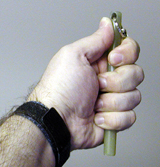 Pocket
Pocket
sticks go by various names. Many people call them kubotans
(named for
Tak Kubota) or yawara
sticks (which might strike some as calling a bo a “bo staff,” but
let’s not get picky here). Don Cunningham, in his book Secret Weapons of
Jujutsu, indicates that fist loads were sometimes referred to as tenouchi
(literally, “inside the hand”). There is also the koppo,
a pocket stick with a loop of cord for the index and middle fingers. (The
concept is similar to that of the suntetsu, also described in Mr. Cunningham’s
book — a metal pocket stick with a metal or flexible loop for the middle
finger.)
Don Rearic’s
excellent website includes several articles on the koppo and related pocket
sticks. The polymer koppo keychain pictured at right was created by Mr.
Rearic.
USING POCKET STICKS
Techniques used with pocket sticks can be as simple or as
complex as you decide to make them. I’ll let you seek out the various
resources on the yawara, particularly, or the manual(s) written for Tak Kubota’s
kubotan. To summarize, however, pocket sticks can be used in the following
ways:

- As fist loads
(though the weight is negligible, pocket sticks lend rigidity to the fist) - For
hammerfist
strikes - For open-hand strikes
and blocks (in the case of the koppo and suntetsu) - For
thrusting
attacks to vulnerable points (eyes, throat, pressure points, certain
muscles) - To facilitate joint locks and control/compliance
techniques (most often as a lever)
Many people carry the pocket stick as a keychain, which
makes good sense. Keychains are seen by most others (including authority
figures) as just that — benign, everyday items. On
a trip to a Six Flags amusement park after September 11, 2001, my wife and I
were confronted by metal detectors at the main gate. My tiny Swiss Army
Knife and Leatherman Micra were confiscated, but they let me walk away with my
polymer
koppo without giving it a second glance.
If you do carry a pocket stick as a keychain, avoid the
ridiculous advice to use it as a handle with which to flail your cluster of keys
at an attacker. This might irritate someone but is of very little
offensive (or defensive) value. Keys are just too light to accomplish much
when used in this fashion (though of course flicking them to the attacker’s eyes
will have some effect).
I carry my car key on my koppo. The key is attached
with a quick-detach
keyring so I don’t have to leave my koppo if I need to surrender my car key
to a mechanic or rental agency. (Quick-detach rings are cheap and readily
available wherever car accessories are sold. Buy yourself a few to keep
for each pocket stick. If possible, buy the same brand so you can detach
your key from one pocket stick and attach it again to another one if you feel
like switching them.)
One of the most common questions people ask about pocket
sticks (after inquiring about how to use them for defense) is how to carry
them. Everyone is different. Depending on your body type, you may
find them uncomfortable to carry in your front pockets. I’ve read accounts
of people who carry them upright in their back pockets next to their wallets,
with or without paracord lanyards to facilitate pulling them out (some people find that
keys on the pocket stick get in the way when using the stick for defensive
techniques or locks or what have you). You might choose to carry the pocket stick in the front or
inside pocket of a jacket. You might also simply carry it in your hand all
the time, if you’re one of those people who almost never carries keys in his or
her pockets when out and about.
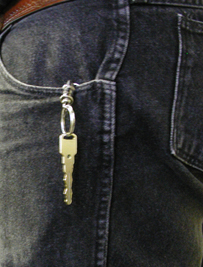 My
My
own preference is to carry a single car key on my koppo. The key dangles
freely from my pocket as it would if the keys were attached to one of those belt
rings some folks wear. (Yes, it jingles about a bit, and yes, if you’re
afraid of muggers running past to snag lanyards or other items hanging from your
pockets, you will not be comfortable with this method.) The key keeps the
pocket stick more or less in the same position all the time and provides me with
an easy means of drawing it.
When I draw the koppo (with my left hand — I have become
accustomed to performing pocket stick techniques with the left hand because that is where
I carry my keys in order to leave my right front pocket free for a tactical
folding knife), the key helps me index the
pocket stick automatically. As the pocket stick
is
drawn up, it is in the perfect position
for hammerfist strikes while the key is in my hand and ready for a quick
entry to the automobile.
As with everything, how you choose to carry and deploy
your pocket stick is a function of what works best for you. You still have
many options before you, however. You must choose from wooden, metal, and
plastic pocket sticks from a variety of manufacturers and sources.
SELECTING POCKET STICKS
The
standard
kubotan is fairly widely available and a pretty good choice. I’ve seen
them of plastic and metal. The same basic shape can also be
had
in wood. What you prefer will depend largely on the relative weights
of the sticks.
One substitute for pocket sticks that is even more
innocuous in appearance than these keychains is small flashlights. The
standard
AA maglight is the perfect size for use as a pocket stick (though striking
with real force is almost certain to damage it in some way). By way of my
friend Don
Rearic I learned to apply to a flashlight a “koppo barrel wrap,” as
illustrated below by Don. This provides a loop for the fingers. (To learn
to do this, buy a good book on knots. Get some cord and experiment —
there is no substitute for practice. I’ve written an article on it
here.) There are
other methods of applying finger rings to these tools, too.
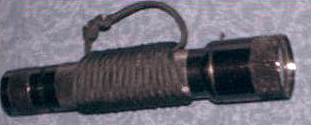
“Koppo-ized”
flashlight. Photo by Don Rearic.
There are quite a few tapered metal pocket sticks on the
market. The taper makes blows with the tip of the pocket stick more
powerful by concentrating the force in a smaller area. This may or may not
be a good thing. Some may find these types of sticks are actually less
comfortable in the pocket. Others will worry that a tapered stick is more
likely to be seen as a weapon should the owner be stopped and searched by a
police officer or security guard.
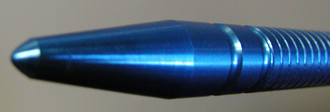
Tapered pocket stick in anodized
aluminum.
Pocket stick lengths vary a bit, with the tapered aluminum
sticks often a bit shorter than the nontapered wooden, plastic, or metal
sticks. This may make a difference to you depending on how you choose to
carry your pocket stick. I know that the length of my polymer koppo is
perfect for the size of my pockets, while a shorter or heavier stick might slip
inside rather than sitting where I prefer to keep it.
Be advised, when selecting a pocket stick, that if you
carry it as a keychain and use it with your car keys, it might be possible for
the weight of the stick and keys to cause some kind of problem with your
ignition. I’ve never had this problem myself and find it hard to believe,
but I’ve been told by others that the possibility exists. Personally, I
think you’d have to have a brick attached to your car key before it would be an
issue.
If you prefer your pocket stick smaller rather than
longer, which puts it in the “fist load” category as it shrinks to fit
completely in your palm, you may prefer the Shomer-Tec
Ti-Bop. This titanium fist load is very comfortable (the knurling is
just right, in my opinion), light, strong, and has an elastic finger loop that
eliminates the need for tedious sizing and resizing of the loop. The
Ti-Bop cannot be used as a keychain, however, so be aware that you’re now
carrying something that a police officer might consider “reverse brass
knuckles.”
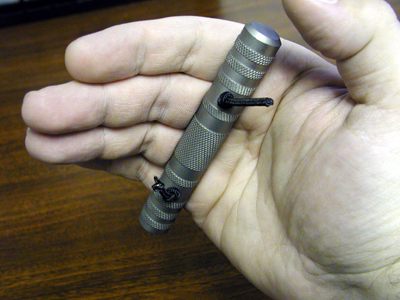
Shomer-Tec Ti-Bop.
ITEMS TO AVOID
There are a few pocket-stick-style implements on
the market, relatively common in martial arts catalogs and stores, that I do not
recommend. Any of the metal pocket sticks incorporating concealed blades
are poor choices. Such a device will get you in a great deal of trouble if
its true nature is discovered by a curious law enforcement officer. As the
blade takes a great deal of time to remove and reattach to the body of the
“stick,” it cannot be employed when you need it anyway — rendering
the whole device an exercise in folly. The risks outweigh the dubious
benefits. The same is true for the pocket sticks that look like metal
kubotans and are hollow inside for carrying metal “throwing spikes.”


The “Ninja Keyrings”
available that have metal protrusions that thrust out between the fingers are
similarly poor ideas. For one thing, it’s difficult to see these devices
as keychains — they practically scream “offensive weapon.” For
another thing, they’re bulky, awkward, and difficult to carry comfortably.
Don’t waste your money on these.
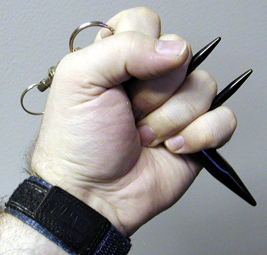
PURCHASING POCKET STICKS
One source for pocket sticks is Self
Defense Gear. They provided me with excellent service, superb
customer communication, and genuine enthusiasm for the concept of self-defense.
Their plain metal
kubotan-style pocket stick was of noticeably
better quality than the (albeit lighter) kubotan I purchased elsewhere (foreground).
The site also has an extensive
selection of tapered aluminum
pocket sticks.
What makes SDG unique, however (and the reason I
recommend them by name here), is the willingness of its staff to take existing
materials and ideas discussed online and make them reality — reality you can buy
and with which you can equip yourself. Borrowing the koppo concept and
applying it to their stock of tapered metal sticks, SDG produces
a hybrid called the “Koppo-ton” that combines the two in a single
package.
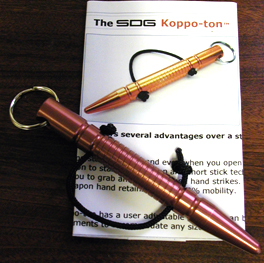
Because the Koppo-tons are made from
existing stock, they can be had in the
same colors as the standard aluminum pocket sticks. These are
well-made, strong, and light, though the precision grooves machined into the
body will feel almost sharp to some hands. If you’re used to the
wider grooves on wooden pocket sticks or standard kubotans, it make take a
little while for you to become accustomed to the tactile sensation these
produce.
While I imagine it is difficult to drill out
aluminum neatly, the Koppo-tons display
good workmanship. Each Koppo-ton comes complete with instructions for
adjusting the finger loop. You’ll need a pair of scissors, a lighter, and
of course the stick itself. The same adjustment applies to any koppo that
has a paracord finger loop, so I’ll walk you through it here.
1. Adjust the Koppo-ton’s loop around your
ring and middle fingers until you are comfortable. The loop must be tight
enough so the stick will be retained when you open your hand, but not so tight
that you can’t comfortably slip the loop on and off your fingers.
(Wrestling to pull the thing on your fingers defeats the purpose if you need the
stick in a hurry.)
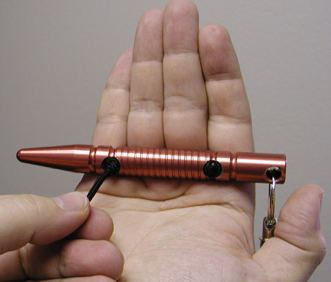
2. Use a loose knot as you
adjust your finger loop. One end should already be tightly knotted, so
you’re adjusting the free end only. (There’s no need to multiply
variables.) Repeat the process as many times as necessary, finally
knotting tightly the free end of the paracord when you are satisfied.
Don’t cut that cord until you’re convinced it’s the right length, or you’ll have
to get more and start all over again. Once you’ve got it just right, clip
the excess.
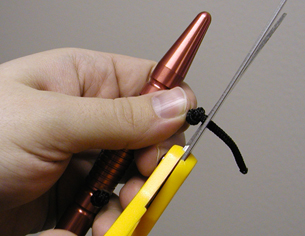
3. Burn the end of the
paracord so it won’t fray. Melt the knot itself a bit to make sure it
won’t come loose. A supply of paracord and a disposable lighter are
must-haves for koppo or Koppo-ton owners.
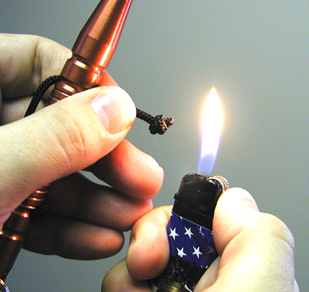
CONCLUSION
There is no excuse for not carrying a pocket
stick, provided there are no laws where you live forbidding them. A
powerful, portable, simple device that greatly amplifies your ability to deliver
force when necessary, the pocket stick is an overlooked and underestimated
self-defense tool. While the material, shape, length, and design of your
pocket stick is a matter of personal preference, the basic concept behind the
device is one that has been applied successfully for centuries.
Do not ignore it.
